Peugeot 308 2014.5 - RHD (UK, Australia) Manual PDF
Manufacturer: PEUGEOT, Model Year: 2014.5, Model line: 308, Model: Peugeot 308 2014.5Pages: 415, PDF Size: 11.57 MB
Page 71 of 415
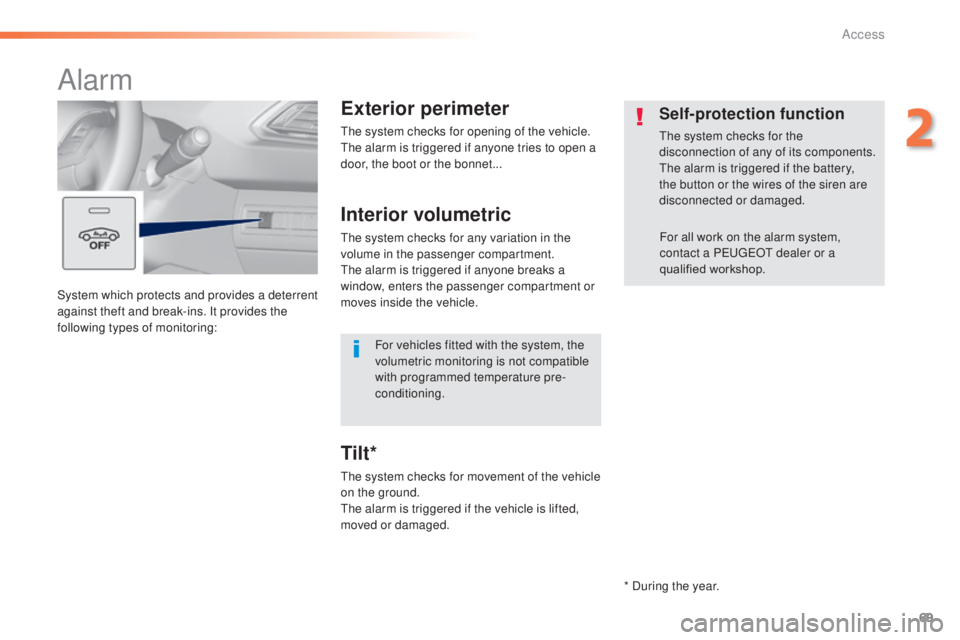
69
System which protects and provides a deterrent
against theft and break-ins. It provides the
following types of monitoring:
Alarm
Exterior perimeter
the system checks for opening of the vehicle.the alarm is triggered if anyone tries to open a
door, the boot or the bonnet...
Self-protection function
the system checks for the
disconnection of any of its components.
th
e alarm is triggered if the battery,
the button or the wires of the siren are
disconnected or damaged.
For all work on the alarm system,
contact a P
e
uge
Ot
dealer or a
qualified workshop.
Interior volumetric
the system checks for any variation in the
volume in the passenger compartment.
th
e alarm is triggered if anyone breaks a
window, enters the passenger compartment or
moves inside the vehicle.
th
e system checks for movement of the vehicle
on the ground.
th
e alarm is triggered if the vehicle is lifted,
moved or damaged.
Tilt*
For vehicles fitted with the system, the
volumetric monitoring is not compatible
with programmed temperature pre-
conditioning.
* During the year.
2
Access
Page 72 of 415
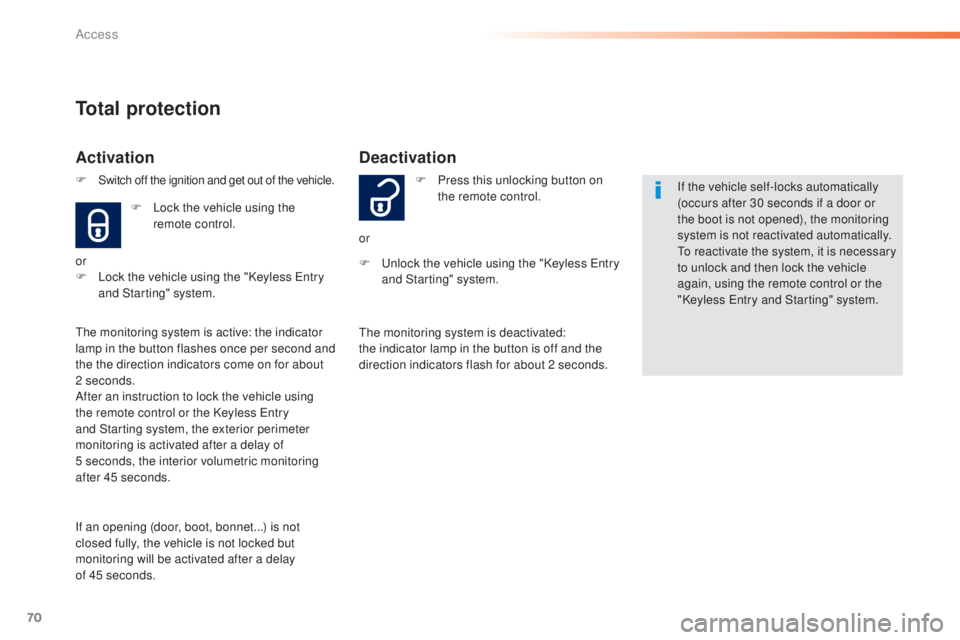
70
Deactivation
F Press this unlocking button on the remote control.
or
F
u
n
lock the vehicle using the "Keyless e
n
try
and Starting" system. If the vehicle self-locks automatically
(occurs after 30 seconds if a door or
the boot is not opened), the monitoring
system is not reactivated automatically.
to r
eactivate the system, it is necessary
to unlock and then lock the vehicle
again, using the remote control or the
"Keyless
e
n
try and Starting" system.
th
e monitoring system is deactivated:
the indicator lamp in the button is off and the
direction indicators flash for about 2 seconds.
Total protection
Activation
F Lock the vehicle using the remote control.
or
F
L
ock the vehicle using the "Keyless e
n
try
and Starting" system.
th
e monitoring system is active: the indicator
lamp in the button flashes once per second and
the the direction indicators come on for about
2 seconds.
After an instruction to lock the vehicle using
the remote control or the Keyless
e
n
try
and Starting system, the exterior perimeter
monitoring is activated after a delay of
5
seconds, the interior volumetric monitoring
after 45 seconds.
If an opening (door, boot, bonnet...) is not
closed fully, the vehicle is not locked but
monitoring will be activated after a delay
of 45 seconds. F
Switch off the ignition and get out of the vehicle.
Access
Page 73 of 415
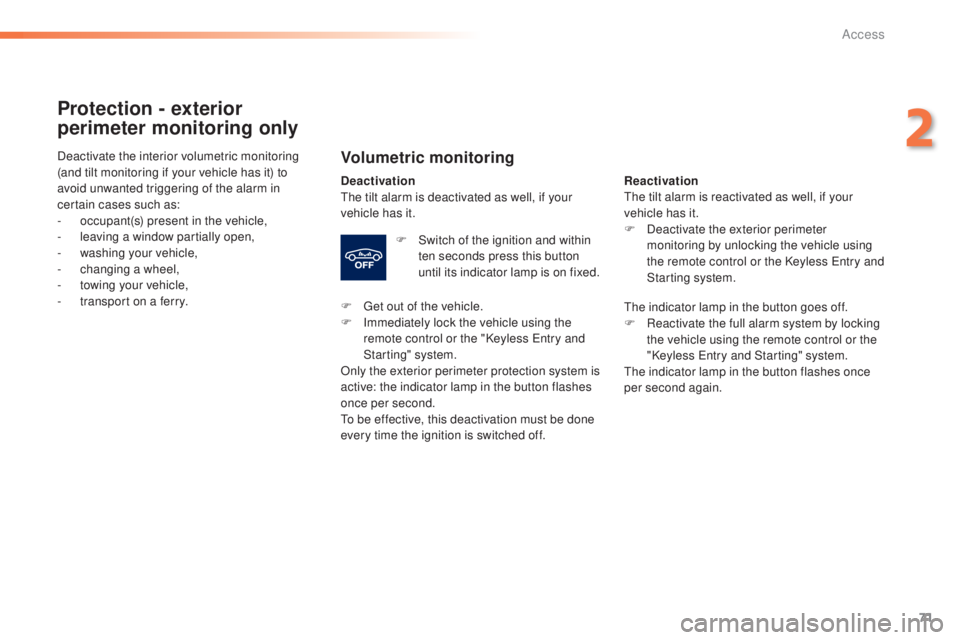
71
Protection - exterior
perimeter monitoring only
Volumetric monitoring
Deactivationthe tilt alarm is deactivated as well, if your
vehicle has it.
F
S
witch of the ignition and within
ten seconds press this button
until its indicator lamp is on fixed.
F
g
e
t out of the vehicle.
F
I
mmediately lock the vehicle using the
remote control or the "Keyless
e
n
try and
Starting" system.
Only the exterior perimeter protection system is
active: the indicator lamp in the button flashes
once per second.
to b
e effective, this deactivation must be done
every time the ignition is switched off.
Deactivate the interior volumetric monitoring
(and tilt monitoring if your vehicle has it) to
avoid unwanted triggering of the alarm in
certain cases such as:
-
o
ccupant(s) present in the vehicle,
-
l
eaving a window partially open,
-
w
ashing your vehicle,
-
c
hanging a wheel,
-
t
owing your vehicle,
-
t
ransport on a ferry. Reactivationth
e tilt alarm is reactivated as well, if your
vehicle has it.
F
D
eactivate the exterior perimeter
monitoring by unlocking the vehicle using
the remote control or the Keyless
e
n
try and
Starting system.
th
e indicator lamp in the button goes off.
F
R
eactivate the full alarm system by locking
the vehicle using the remote control or the
"Keyless
e
n
try and Starting" system.
th
e indicator lamp in the button flashes once
per second again.
2
Access
Page 74 of 415
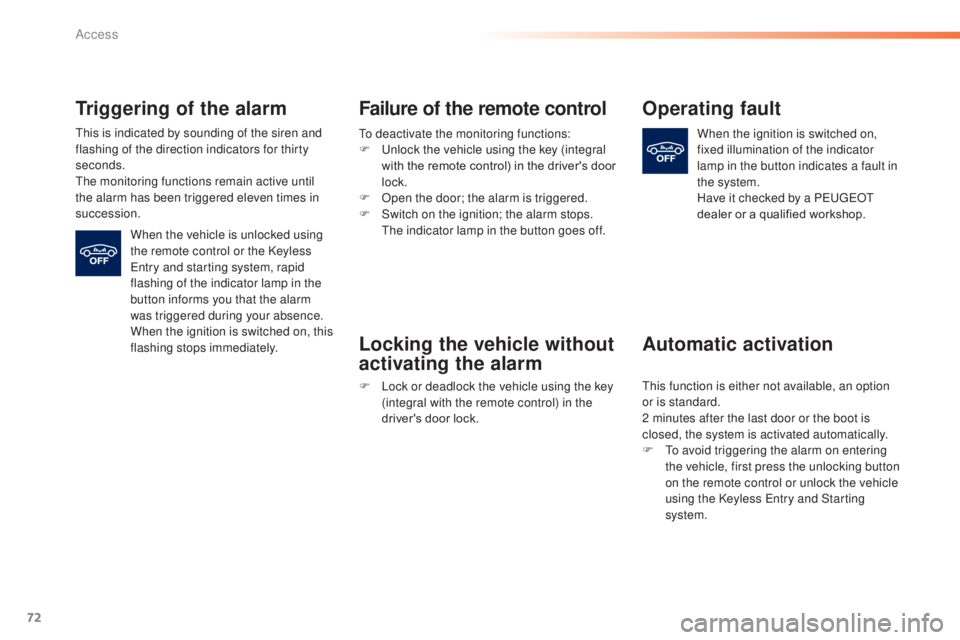
72
Triggering of the alarm
this is indicated by sounding of the siren and
flashing of the direction indicators for thirty
seconds.
th
e monitoring functions remain active until
the alarm has been triggered eleven times in
succession.
When the vehicle is unlocked using
the remote control or the Keyless
en
try and starting system, rapid
flashing of the indicator lamp in the
button informs you that the alarm
was triggered during your absence.
When the ignition is switched on, this
flashing stops immediately.
Failure of the remote control
to deactivate the monitoring functions:
F un lock the vehicle using the key (integral
with the remote control) in the driver's door
lock.
F
O
pen the door; the alarm is triggered.
F
S
witch on the ignition; the alarm stops.
th
e indicator lamp in the button goes off.
Locking the vehicle without
activating the alarm
F Lock or deadlock the vehicle using the key (integral with the remote control) in the
driver's door lock.
Operating fault
When the ignition is switched on,
fixed illumination of the indicator
lamp in the button indicates a fault in
the system.
Have it checked by a P
e
uge
Ot
dealer or a qualified workshop.
Automatic activation
this function is either not available, an option
or is standard.
2 minutes after the last door or the boot is
closed, the system is activated automatically.
F
t
o a
void triggering the alarm on entering
the vehicle, first press the unlocking button
on the remote control or unlock the vehicle
using the Keyless
e
n
try and Starting
system.
Access
Page 75 of 415
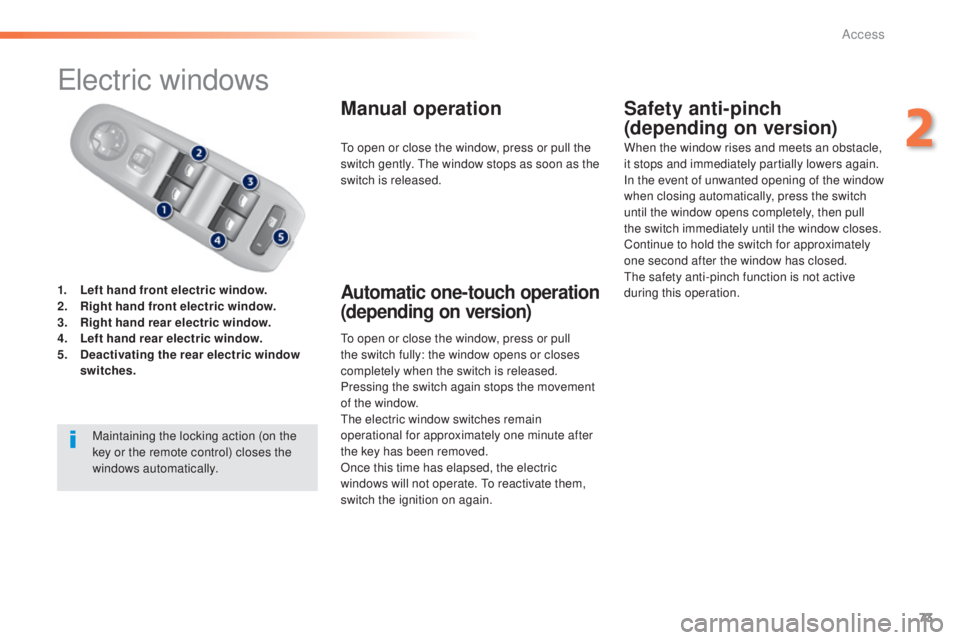
73
electric windows
1. Left hand front electric window.
2. Right hand front electric window.
3.
R
ight hand rear electric window.
4.
Le
ft hand rear electric window.
5.
D
eactivating the rear electric window
switches .
Manual operation
to open or close the window, press or pull
the switch fully: the window opens or closes
completely when the switch is released.
Pressing the switch again stops the movement
of the window.
the
electric window switches remain
operational for approximately one minute after
the key has been removed.
Once this time has elapsed, the electric
windows will not operate.
t
o r
eactivate them,
switch the ignition on again.
Safety anti-pinch
(depending on version)
Automatic one-touch operation
(depending on version)
to open or close the window, press or pull the
switch gently. th e window stops as soon as the
switch is released. When the window rises and meets an obstacle,
it stops and immediately partially lowers again.
In the event of unwanted opening of the window
when closing automatically, press the switch
until the window opens completely, then pull
the switch immediately until the window closes.
Continue to hold the switch for approximately
one second after the window has closed.
th
e safety anti-pinch function is not active
during this operation.
Maintaining the locking action (on the
key or the remote control) closes the
windows automatically.
2
Access
Page 76 of 415
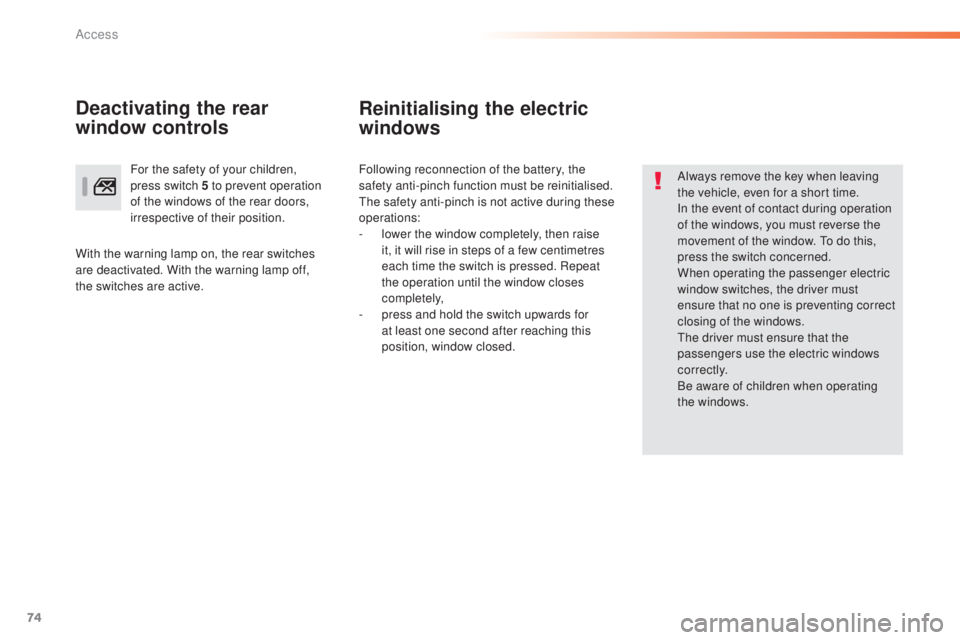
74
Reinitialising the electric
windows
Always remove the key when leaving
the vehicle, even for a short time.
In the event of contact during operation
of the windows, you must reverse the
movement of the window. t
o d
o this,
press the switch concerned.
When operating the passenger electric
window switches, the driver must
ensure that no one is preventing correct
closing of the windows.
th
e driver must ensure that the
passengers use the electric windows
c o r r e c t l y.
Be aware of children when operating
the windows.
Following reconnection of the battery, the
safety anti-pinch function must be reinitialised.
th
e safety anti-pinch is not active during these
operations:
-
l
ower the window completely, then raise
it, it will rise in steps of a few centimetres
each time the switch is pressed. Repeat
the operation until the window closes
completely,
-
p
ress and hold the switch upwards for
at least one second after reaching this
position, window closed.
For the safety of your children,
press switch 5 to prevent operation
of the windows of the rear doors,
irrespective of their position.
Deactivating the rear
window controls
With the warning lamp on, the rear switches
are deactivated. With the warning lamp off,
the switches are active.
Access
Page 77 of 415
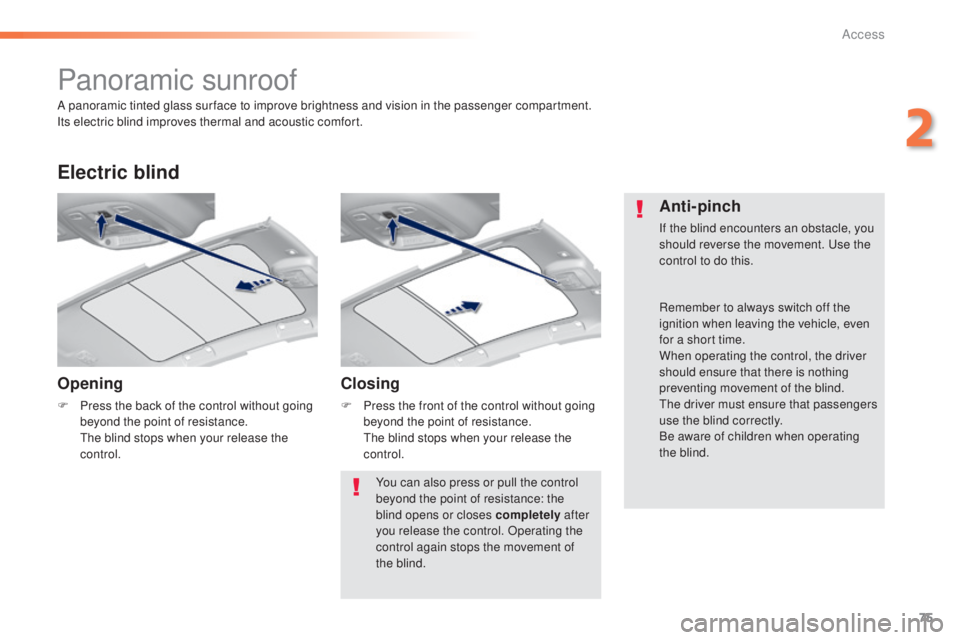
75
Panoramic sunroof
Opening
F Press the back of the control without going beyond the point of resistance.
t
he
blind stops when your release the
control.
Electric blind
Closing
F Press the front of the control without going beyond the point of resistance.
t
he
blind stops when your release the
control.
Anti-pinch
If the blind encounters an obstacle, you
should reverse the movement. use the
control to do this.
A panoramic tinted glass sur face to improve brightness and vision in the passenger compartment.
Its electric blind improves thermal and acoustic comfort.
You can also press or pull the control
beyond the point of resistance: the
blind opens or closes completely after
you release the control. Operating the
control again stops the movement of
the blind. Remember to always switch off the
ignition when leaving the vehicle, even
for a short time.
When operating the control, the driver
should ensure that there is nothing
preventing movement of the blind.
the
driver must ensure that passengers
use the blind correctly.
Be aware of children when operating
the blind.
2
Access
Page 78 of 415
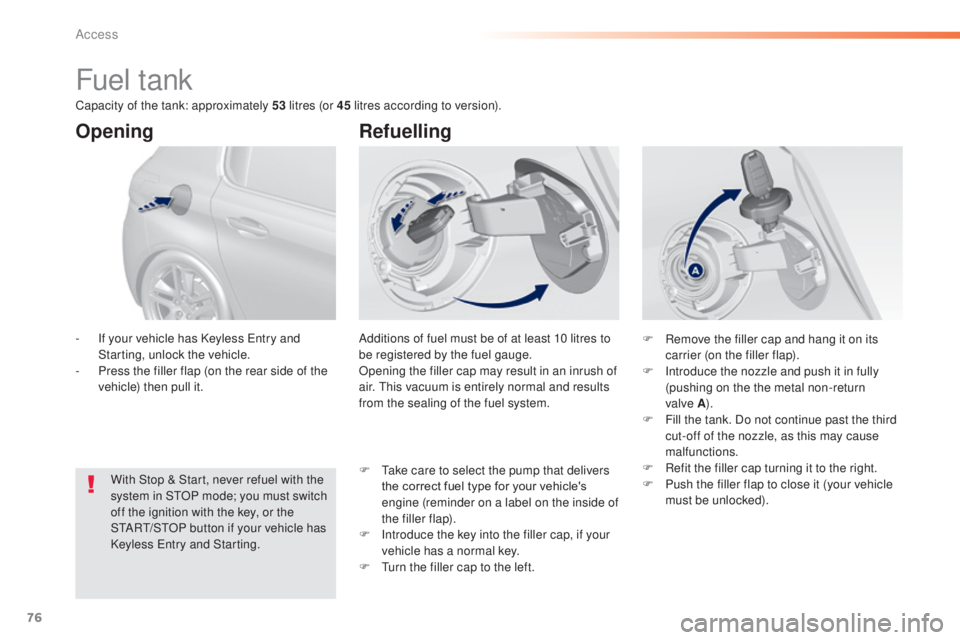
76
Fuel tank
Additions of fuel must be of at least 10 litres to
be registered by the fuel gauge.
Opening the filler cap may result in an inrush of
air. t
h
is vacuum is entirely normal and results
from the sealing of the fuel system.
Opening
With Stop & Start, never refuel with the
system in StO P mode; you must switch
off the ignition with the key, or the
S
tA
R
t/
S
tO
P button if your vehicle has
Keyless
e
n
try and Starting.
-
I
f your vehicle has Keyless e
n
try and
Starting, unlock the vehicle.
-
P
ress the filler flap (on the rear side of the
vehicle) then pull it.
Refuelling
F Remove the filler cap and hang it on its carrier (on the filler flap).
F
I
ntroduce the nozzle and push it in fully
(pushing on the the metal non-return
valve
A).
F
F
ill the tank. Do not continue past the third
cut-off of the nozzle, as this may cause
malfunctions.
F
R
efit the filler cap turning it to the right.
F
P
ush the filler flap to close it (your vehicle
must be unlocked).
F
t
a
ke care to select the pump that delivers
the correct fuel type for your vehicle's
engine (reminder on a label on the inside of
the filler flap).
F
I
ntroduce the key into the filler cap, if your
vehicle has a normal key.
F
t
u
rn the filler cap to the left.
Capacity of the tank: approximately 53
litres (or 45 litres according to version).
Access
Page 79 of 415
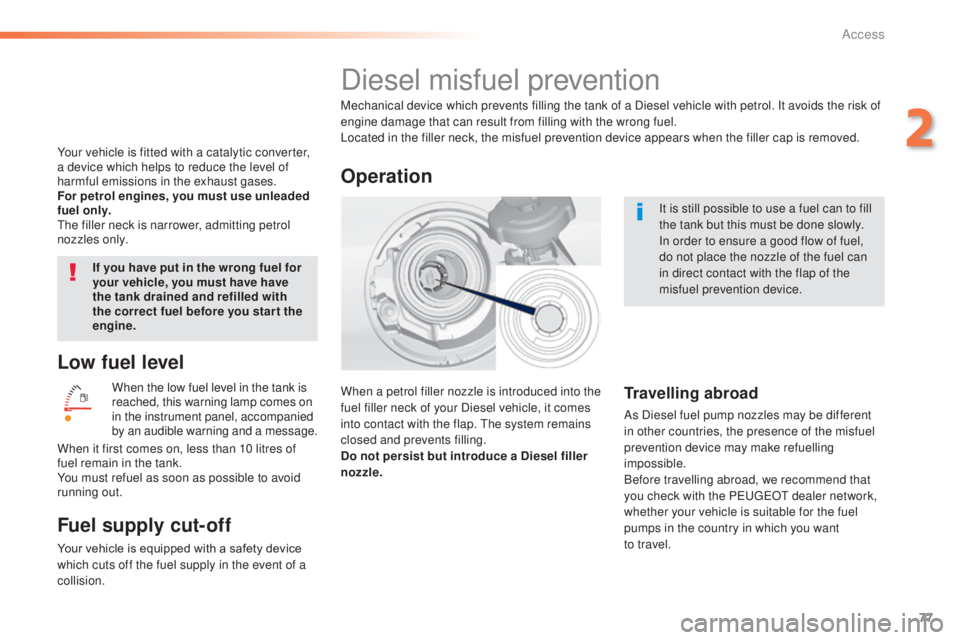
77
Low fuel level
When the low fuel level in the tank is
reached, this warning lamp comes on
in the instrument panel, accompanied
by an audible warning and a message.
Fuel supply cut-off
Your vehicle is equipped with a safety device
which cuts off the fuel supply in the event of a
collision.It is still possible to use a fuel can to fill
the tank but this must be done slowly.
In order to ensure a good flow of fuel,
do not place the nozzle of the fuel can
in direct contact with the flap of the
misfuel prevention device.
Diesel misfuel prevention
Mechanical device which prevents filling the tank of a Diesel vehicle with petrol. It avoids the risk of
engine damage that can result from filling with the wrong fuel.
Located in the filler neck, the misfuel prevention device appears when the filler cap is removed.
When a petrol filler nozzle is introduced into the
fuel filler neck of your Diesel vehicle, it comes
into contact with the flap.
t
h
e system remains
closed and prevents filling.
Do not persist but introduce a Diesel filler
nozzle.
Operation
Travelling abroad
As Diesel fuel pump nozzles may be different
in other countries, the presence of the misfuel
prevention device may make refuelling
impossible.
Before travelling abroad, we recommend that
you check with the P
e
uge
Ot
dealer network,
whether your vehicle is suitable for the fuel
pumps in the country in which you want
to
travel.
When it first comes on, less than 10 litres of
fuel remain in the tank.
You must refuel as soon as possible to avoid
running out. If you have put in the wrong fuel for
your vehicle, you must have have
the tank drained and refilled with
the correct fuel before you star t the
engine.
Your vehicle is fitted with a catalytic converter,
a device which helps to reduce the level of
harmful emissions in the exhaust gases.
For petrol engines, you must use unleaded
fuel only.
th
e filler neck is narrower, admitting petrol
nozzles only.
2
Access
Page 80 of 415
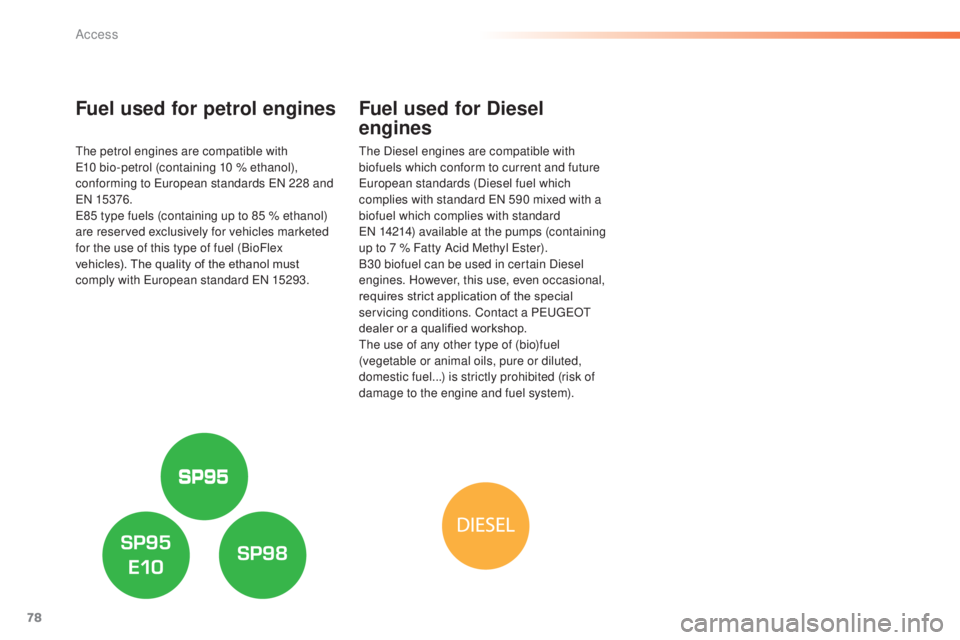
78
Fuel used for petrol engines
the petrol engines are compatible with e10 bio-petrol (containing 10 % ethanol),
conforming to
e
u
ropean standards e
N 2
28 and
eN
15376.
e8
5 type fuels (containing up to 85 % ethanol)
are reserved exclusively for vehicles marketed
for the use of this type of fuel (BioFlex
vehicles). The quality of the ethanol must
comply with
e
u
ropean standard e
N 1
5293.
Fuel used for Diesel
engines
the Diesel engines are compatible with
biofuels which conform to current and future
eu
ropean standards (Diesel fuel which
complies with standard
e
N 5
90 mixed with a
biofuel which complies with standard
eN 1
4214) available at the pumps (containing
up to 7 % Fatty Acid Methyl
e
s
ter).
B30 biofuel can be used in certain Diesel
engines. However, this use, even occasional,
requires strict application of the special
servicing conditions. Contact a P
e
uge
Ot
dealer or a qualified workshop.
th
e use of any other type of (bio)fuel
(vegetable or animal oils, pure or diluted,
domestic fuel...) is strictly prohibited (risk of
damage to the engine and fuel system).
Access